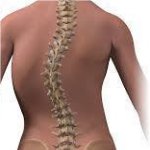Contraction of the diaphragm is likely a key driver of scoliosis.
A new study examined 10 subjects with scoliosis. The study found that although paradoxical inward motion of the ribcage is evident in many patients with scoliosis, the motion was eliminated through the use of noninvasive ventilation. Because noninvasive ventilation is fulfilling the role of the respiratory muscles, the fact that the scoliosis changed when the diaphragm relaxed suggests that the diaphragm is likely playing a key role in scoliosis. The authors conclude that this is not surprising due to the orientation of the diaphragm fibers.
Conclusions
Because the right diaphragm sits nicely on top of the liver and the left diaphragm does not, it is not hard to see that one diaphragm might become more active than the other and consequently lead to an asymmetry in the bend of the spine. Ensuring that both sides of the diaphragm are both functioning properly may be a high priority for ensuring optimal spinal function and movement capacity.
References
